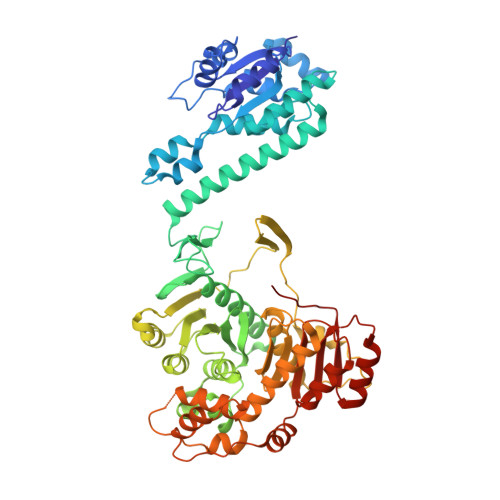Structural Insights into the Human and Avian IMP Cyclohydrolase Mechanism via Crystal Structures with the Bound XMP Inhibitor.
Wolan, D.W., Cheong, C.G., Greasley, S.E., Wilson, I.A.(2004) Biochemistry 43: 1171-1183
- PubMed: 14756553
- DOI: https://doi.org/10.1021/bi030162i
- Primary Citation of Related Structures:
1PKX - PubMed Abstract:
Within de novo purine biosynthesis, the AICAR transformylase and IMP cyclohydrolase activities of the bifunctional enzyme ATIC convert the intermediate AICAR to the final product of the pathway, IMP. Identification of the AICAR transformylase active site and a proposed formyl transfer mechanism have already resulted from analysis of crystal structures of avian ATIC in complex with substrate and/or inhibitors. Herein, we focus on the IMPCH active site and the cyclohydrolase mechanism through comparison of crystal structures of XMP inhibitor complexes of human ATIC at 1.9 A resolution with the previously determined avian enzyme. This first human ATIC structure was also determined to ascertain whether any subtle structural differences, compared to the homologous avian enzyme, should be taken into account for structure-based inhibitor design. These structural comparisons, as well as comparative analyses with other IMP and XMP binding proteins, have enabled a catalytic mechanism to be formulated. The primary role of the IMPCH active site appears to be to induce a reconfiguration of the substrate FAICAR to a less energetically favorable, but more reactive, conformer. Backbone (Arg64 and Lys66) and side chain interactions (Thr67) in the IMPCH active site reorient the 4-carboxamide from the preferred conformer that binds to the AICAR Tfase active site to one that promotes intramolecular cyclization. Other backbone amides (Ile126 and Gly127) create an oxyanion hole that helps orient the formyl group for nucleophilic attack by the 4-carboxamide amine and then stabilize the anionic intermediate. Several other residues, including Lys66, Tyr104, Asp125, and Lys137', provide substrate specificity and likely enhance the catalytic rate through contributions to acid-base catalysis.
Organizational Affiliation:
Department of Molecular Biology and The Skaggs Institute for Chemical Biology, The Scripps Research Institute, 10550 North Torrey Pines Road, La Jolla, California 92037, USA.
















